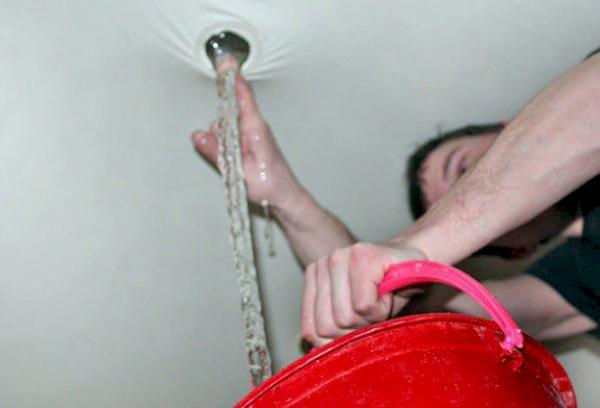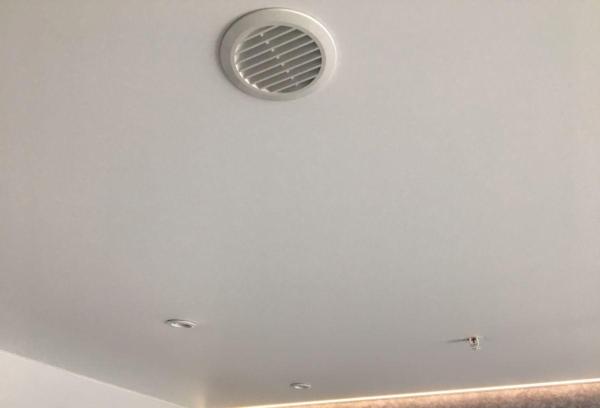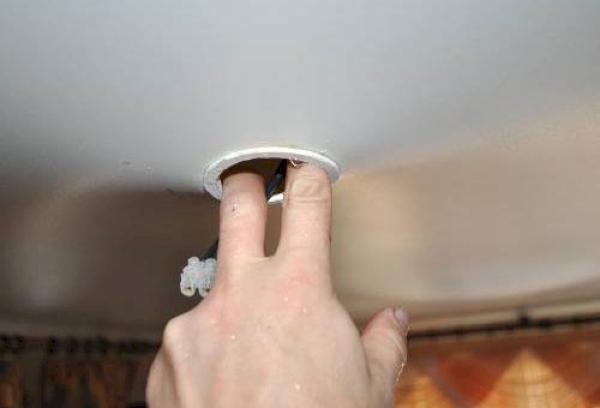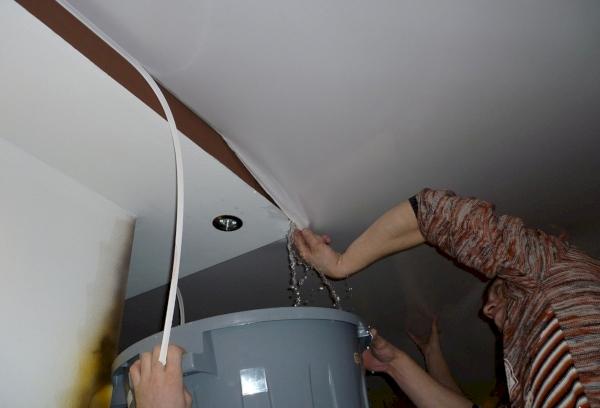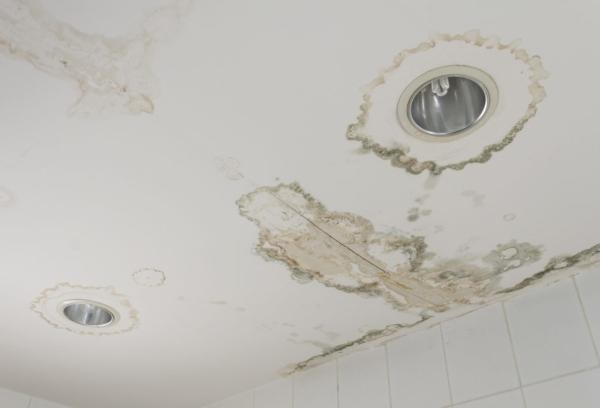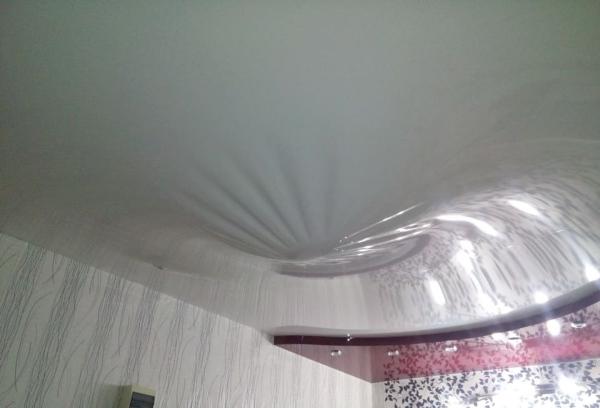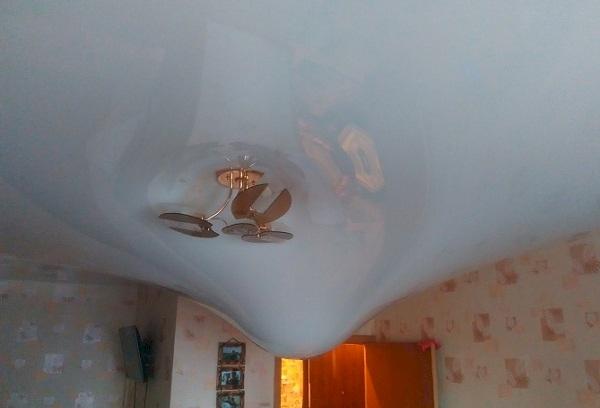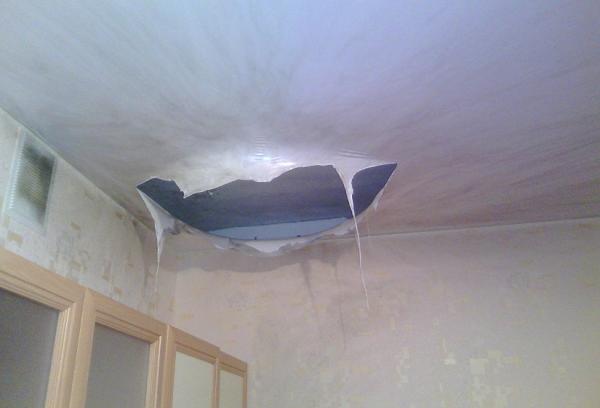How to remove water from a suspended ceiling yourself
Content:
The question of how to drain water from a suspended ceiling often arises in cases where unexpected flooding occurred from neighbors above or snow began to melt on a leaky roof.
Even the most durable and high-quality polyvinyl chloride film from which the ceiling is made may not withstand the powerful pressure of a large amount of water. If the material breaks through, all the furniture, carpets and renovations in the apartment will be hopelessly damaged.
How to remove water from a suspended ceiling yourself
The advantage of suspended ceilings is their ability to retain water and protect the apartment from flooding. The disadvantage is that the problem of water drainage must be solved immediately, and such a service is not cheap.

In addition, a flood can occur on the weekend or at night, which means homeowners will have to drain the water themselves.
Sequencing
First of all, in order to avoid short circuits and electric shock to residents, it is necessary to immediately turn off the electricity in the apartment after detecting a flooding problem.
Then you should establish why the apartment was flooded and immediately take measures to eliminate it.
The most common causes of flooding:
- a rupture of a water pipe with cold water from neighbors above;
- damage to the heating or hot water supply system;
- rainwater entering the home after heavy rainfall;
- roof leakage when snow melts;
- the washing machine of neighbors on the upper floors breaks down, resulting in the lower apartments being flooded with soapy water;
- technical fluid or antifreeze flowing from an autonomous heating system;
- damage to the sewer pipe and flooding of residents from below with sewage.
If the residents who have a leak are not at home and no one opens the door, you must contact the police. Under no circumstances should you attempt to open your neighbors’ front door yourself, since such an action will be regarded as illegal entry into private housing.
Further actions after eliminating the leak depend on whether there are holes in the ceiling for lamps, or a special valve for draining water.
Important: It is recommended to record on camera all defects resulting from the accident. This will help speed up the decision by the culprit neighbors on material compensation for the damage caused.
When there is a special valve
If the canvas has a special valve that allows water to drain in the event of a leak, then you can drain water from the stretch ceiling in the following way:
- Prepare a hose, containers and a stepladder.
- Open the hole.
- Using a hose, drain the water into basins and buckets.
- Remove the coating and dry it thoroughly.
This work should be done with an assistant who will empty the containers in a timely manner, preparing them for draining subsequent portions of water. The dried canvas is reinstalled on the ceiling with the help of specialists.
If the valve is located on the opposite side of the flood location, you will need to use other methods.
When there are holes for lamps
Holes for lamps can be used to drain water. To do this, you need to find the place where the lighting fixture is located and, if necessary, move the water bubble to the other side from the place where the ceiling sagged. This can be done by using supports, with the help of which the water bubble is raised and distilled to another place.
It is important to carry out this manipulation very carefully so as not to damage the coating. It is most convenient for three people to drain water in this way: the first person holds the hose through which the water is drained, and the hose should first be clamped in the covering, and then lowered, pointing the other end into the container. The second assistant will roll water to the hose, stretching the surface of the coating, and the third assistant will empty the filled basins and buckets.
If for some reason it is necessary to temporarily interrupt the water removal process, the hose is simply pinched or bent.
When there are no holes
If there are no holes in the tension fabric, you will need to unfasten its edge from the baguette. To do the job efficiently, you must try to clear a small area of the coating.
Baguettes of suspended ceilings can be attached in three ways:
- Clip-on – provides for fixing the material using special clips.
- Harpoon - when producing film for a stretch ceiling, its edges are equipped with a rigid curved frame, which is inserted into special grooves in the profile, which is fixed around the perimeter of the room.
- Beading - with this type of fastening, the film is inserted into the profiles and pressed with a bead, which fits tightly into the baguette.
To remove water from a stretch ceiling, you first need to figure out what type of fastening was used to install the canvas.
Most often, installers resort to the harpoon method. To remove the edge of the covering from the profile, you need to take a rounded spatula or a flat-head screwdriver. To unfasten the clips, just press on them, and to remove the bead, first remove the insert that acts as a plinth.
The edge of the canvas must be released very carefully, a few centimeters at a time. In this case, you need to hold it tightly, making sure that the film does not tear out of your hands. The pulled out edge is slightly pulled back, a fold is formed with your hands and lowered down, directing the flow of water into the container.
If the water bubble is too large, it is better to drain it through a hose.
Drying and elimination of consequences
When all the water has been completely drained, the canvas will need to be thoroughly cleaned and dried to avoid the formation of fungus and mold.
To wash vinyl, it is allowed to use water with a temperature of no higher than 60 degrees. Otherwise, the material will melt and deform. For cleaning, you can use only gentle detergents, and for drying, use a technical hair dryer with not too hot air.
If the leak was minor and it was quickly eliminated, then it is better to dry the vinyl film without removing it from the frame. In this case, it is not necessary to clean it.
Stretched from a water bubble, wrinkled and deformed fabric is easily restored using heat treatment. To do this, it is better to seek help from professionals, but if you wish, you can do this work yourself.
To dry the coating and restore its shape, a heat gun or a hair dryer is used. The switched on device is held from the surface of the canvas at a distance of 30-40 cm, trying not to direct the hot stream to one place for more than 10 seconds. When the ceiling is completely dry, you can begin installing the lamps.
If the ceiling canvas is made of fabric, yellow spots and streaks will form on its surface after a flood.
To eliminate them, the following methods are used:
- moisten a soft cloth with ammonia and gently treat the stains. To enhance the cleansing effect, it is recommended to mix ammonia with a soap solution;
- Dishwashing liquid diluted in warm water will help deal with stains;
- Apply a small amount of car interior cleaner onto a clean soft cloth and rub problem areas;
- soak a clean kitchen sponge in hydrogen peroxide and wipe away any stains. This method is effective only for minor stains.
Common Mistakes
Accidents associated with flooding of suspended ceilings do not happen often. Therefore, any person faced with such a problem, due to lack of experience, can make various mistakes in the process of eliminating it.
The most common mistakes are:
- puncture of the bubble in order to drain water through the resulting hole.Under the pressure of water, the puncture will instantly rupture, as a result of which a huge hole can form in the canvas;
- pushing accumulated water towards the holes of the lamp with your hands - this can lead to the formation of scratches and tears on the surface of the coating, as well as the distribution of small amounts of water in different places. Over time, the moisture that gets into the secluded corners will bloom and cause the formation of fungus;
- propping the film with a stick to distribute the water mass over the entire ceiling area. Such an action will lead to the same consequences as when trying to drive waves along the ceiling;
- draining water without preliminary preparation - first you need to prepare containers, call people who will help fix the problem. If during the work it turns out that there are not enough containers and there is nowhere to drain the water, you will subsequently have to remove it from the floor.
How much does it cost to drain water from a suspended ceiling?
Usually the company that installed the ceiling comes to the call and drains the water for free.
But if the installation was carried out a long time ago, and your company no longer exists, you will have to call some other company specializing in the installation of suspended ceilings and pay money for the water drainage service.
Such a service will be paid even if the installation was carried out without concluding an appropriate contract, and the homeowners did not discuss with the installers the issue of solving this problem if it arose.
The approximate price of the service is 4000 rubles.
However, it must be borne in mind that a flood can lead to the collapse of plaster on the ceiling, the formation of stains on the surface of the canvas, as well as the emergence of other problems, for the elimination of which you will have to pay additional money to specialists.
The table below will help you figure out how much restoration services cost:
How much water can a suspended ceiling withstand?
A ceiling made of polyvinyl chloride film can withstand up to 100 liters of water per 1 m². From such an amount of liquid, the material stretches greatly, forming a large bubble hanging down, but the film itself does not tear.
However, polyvinyl chloride can provide such protection only in the event of a cold water leak. If the water is hot, the ceiling will stretch more due to strong heating and can easily tear if it comes into contact with any sharp object in the room.
You also need to take into account that even the most durable and high-quality ceiling can leak 2-3 days after flooding. Even a small amount of liquid over time softens the area where two parts of the welded sheet meet, causing it to crack.
Tip: When choosing a stretch ceiling, you need to pay attention to the markings, information about the characteristics of the material and its technical properties. As a rule, manufacturers indicate the degree of moisture resistance of the product and its ability to withstand a particular weight of water.
The latter indicator may also depend on the following factors:
- the area of the stretch ceiling - the larger it is, the less water it can withstand;
- the degree of tension of the material during installation - if the film is stretched too tightly, this reduces its elasticity and density. Accordingly, a ceiling that is stretched too tightly will tear faster.
- manufacturing material - canvases for suspended ceilings can be made on a fabric basis. Such products are impregnated with a polyurethane compound, which gives them waterproof qualities.But a fabric ceiling with waterproof impregnation can only hold water for a limited time, after which it begins to ooze and flood the room.
Thus, in order to drain water from a suspended ceiling and eliminate the consequences of a flood, you can try to do the work yourself, or seek help from specialists.
If you fix the leak yourself, it is important to first establish and eliminate its cause, as well as prepare everything necessary for draining the water - a stepladder, containers, a hose. A plug for the hose will also help to simplify the work, with the help of which you can avoid constantly squeezing its end with your hands.
